Synthesis of Fe₂O₃/TiO₂/graphene aerogel composite as an efficient Fenton-Photocatalyst for removal of methylene blue from aqueous solution
In the present study, the composites including Fe2O3/TiO2/graphene aerogel (Fe2O3/TiO2/GA) and TiO2/graphene
aerogel (TiO2/GA), and graphene aerogel (GA) were synthesized by hydrothermal method. The as-prepared materials
were characterized using X-ray diffraction, Fourier transform infrared spectroscopy, scanning electron microscopy,
energy dispersive X-ray, Raman spectroscopy. The characterization results showed that the Fe2O3 and TiO2 particles
were uniformly attached in GA structure, increasing number of active sites of materials and extending the light
absorption range. The removal performance of Fe2O3/TiO2/GA is 97.38 % which is higher than of TiO2/GA and TiO2.
The degradation data were well consisted with pseudo-first-order kinetic model. Accordingly, Fe2O3/TiO2/GA is
potential to be used as an efficient photocatalysis for treatment of MB from water.
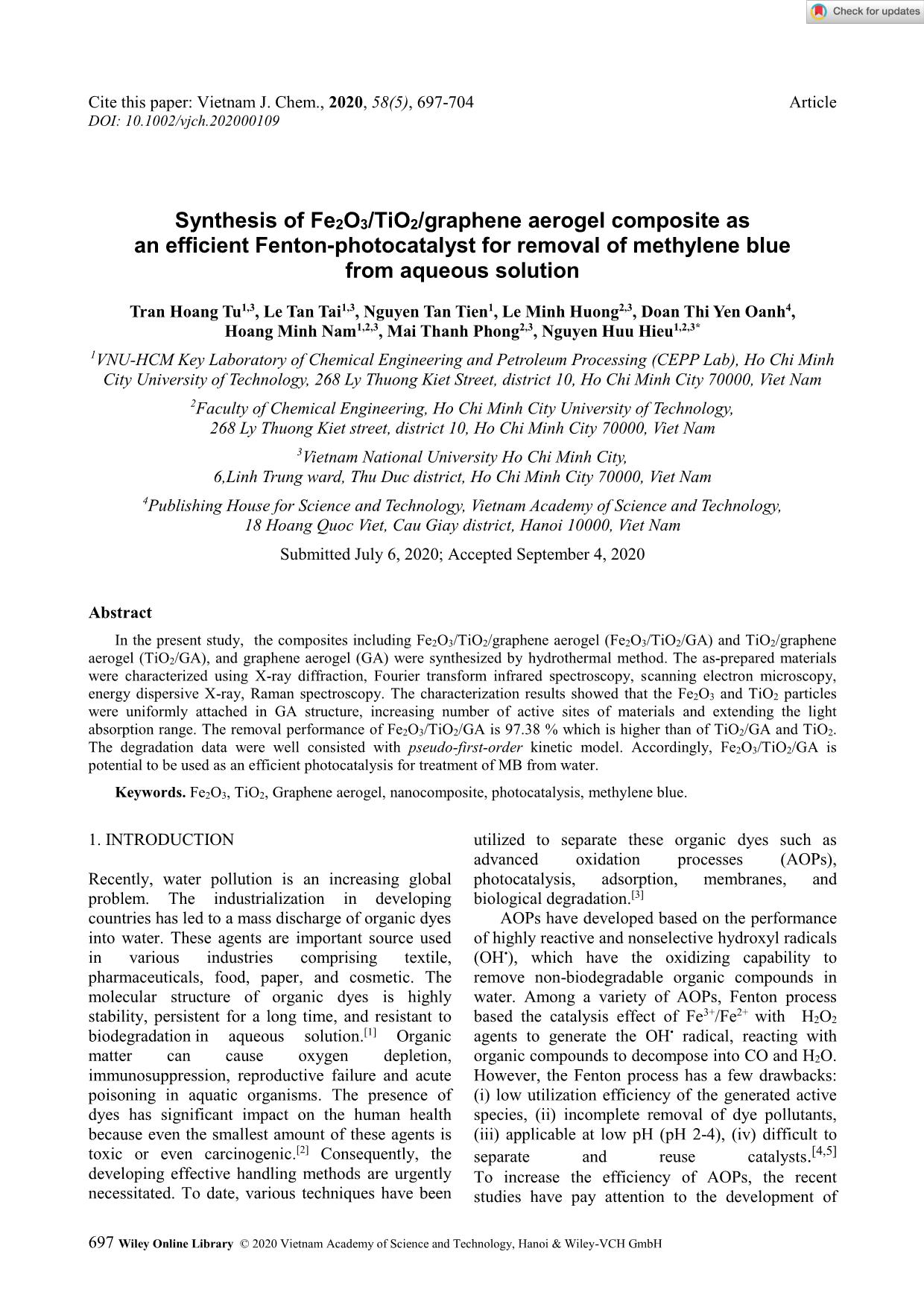
Trang 1
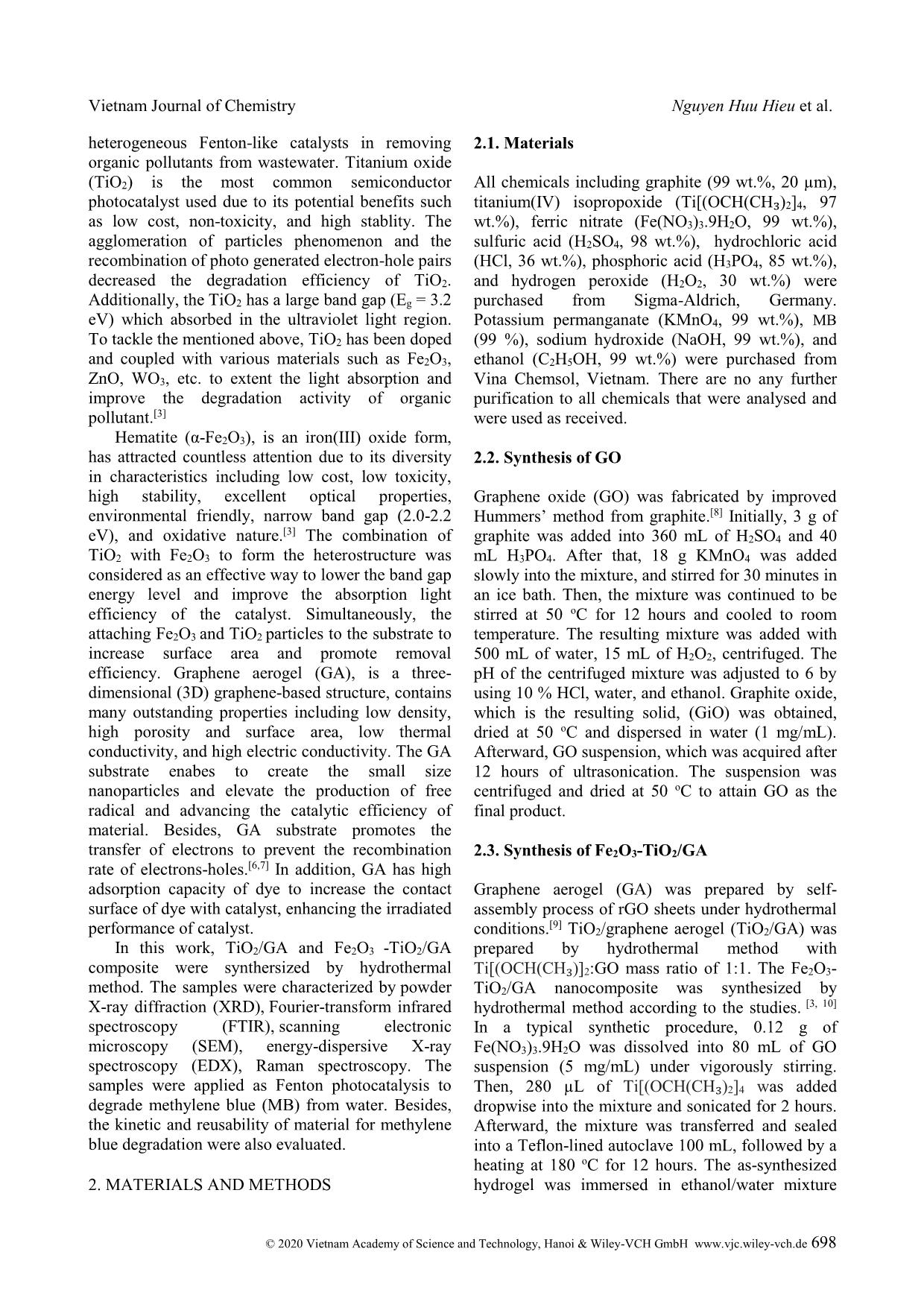
Trang 2
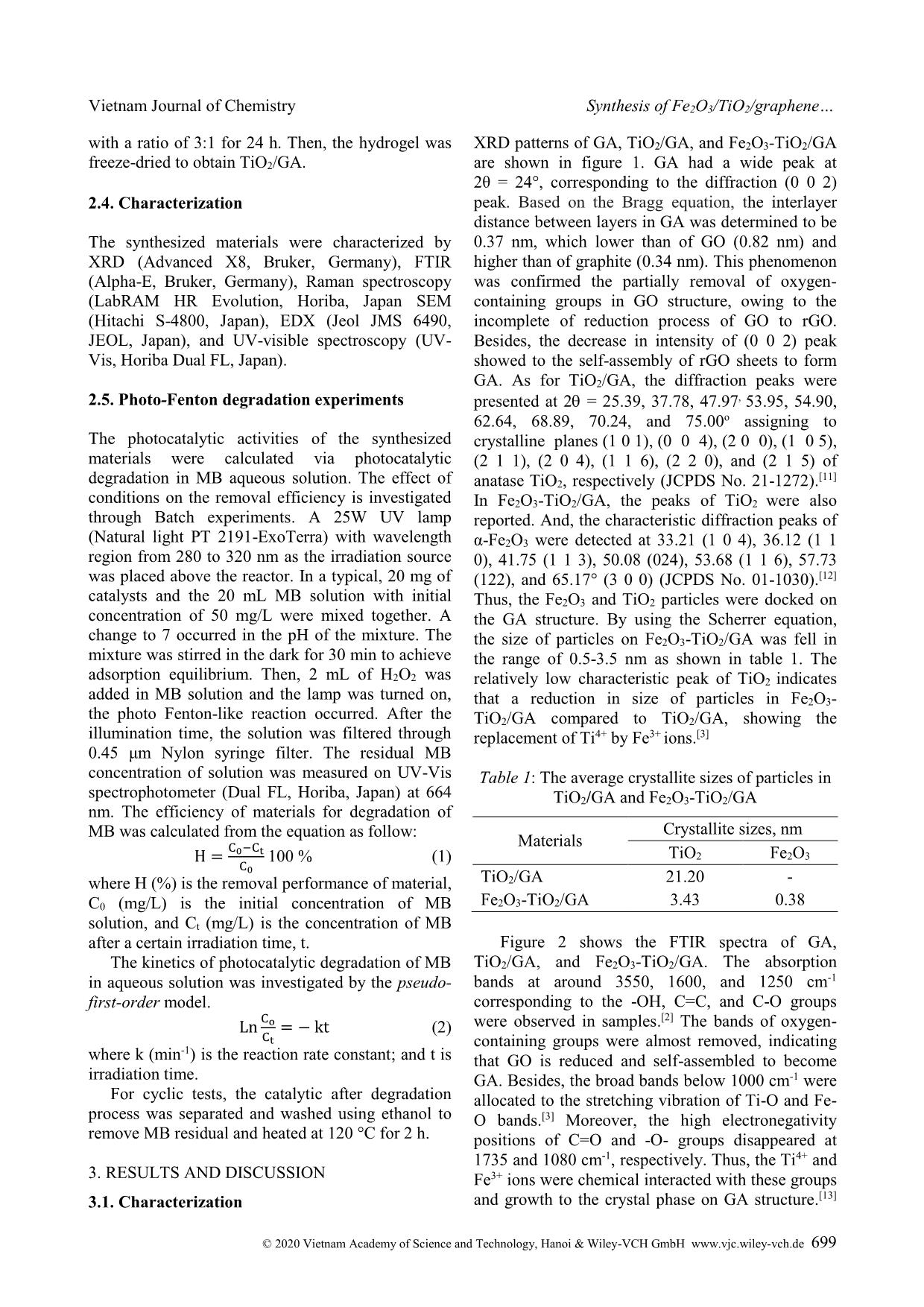
Trang 3
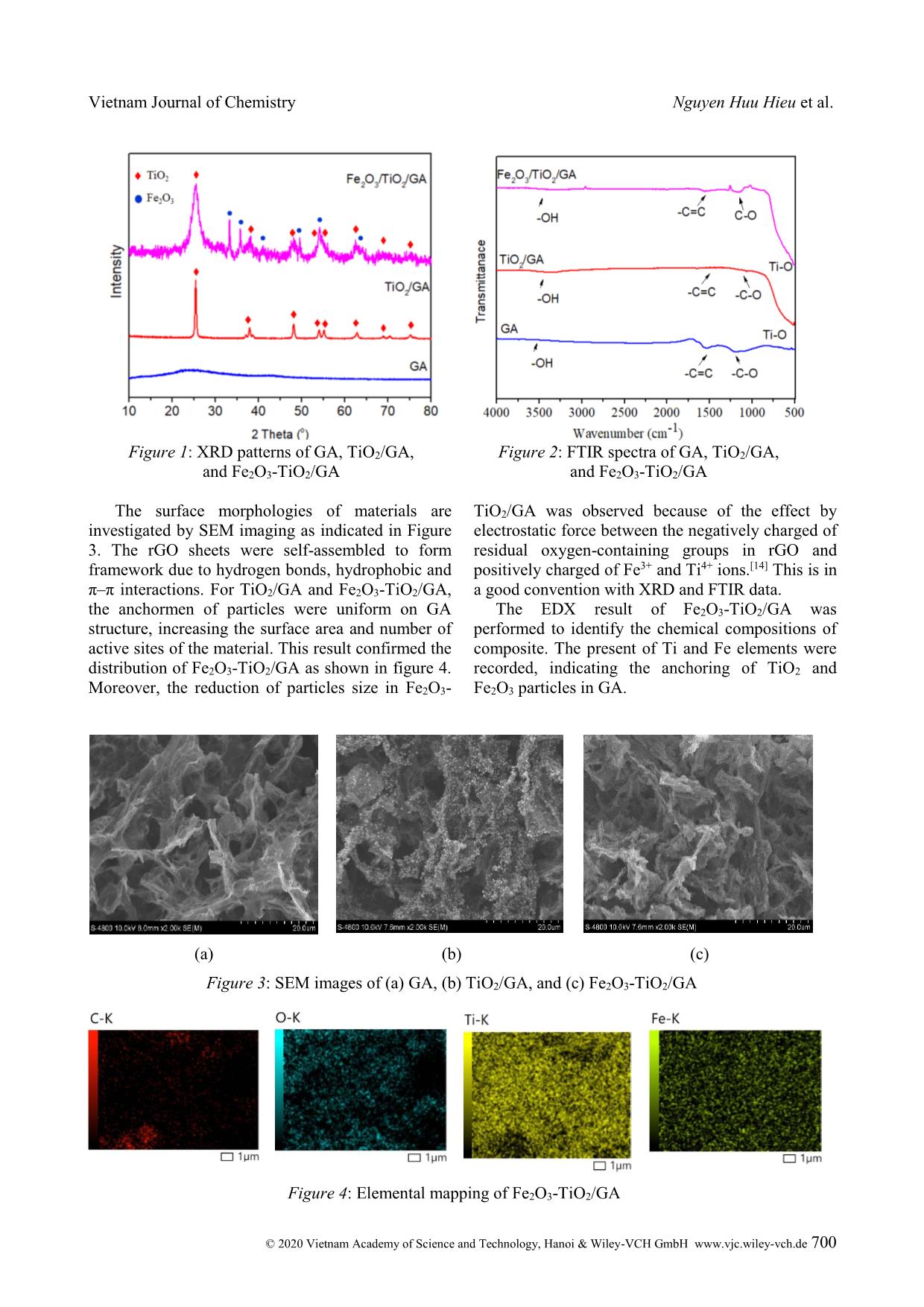
Trang 4
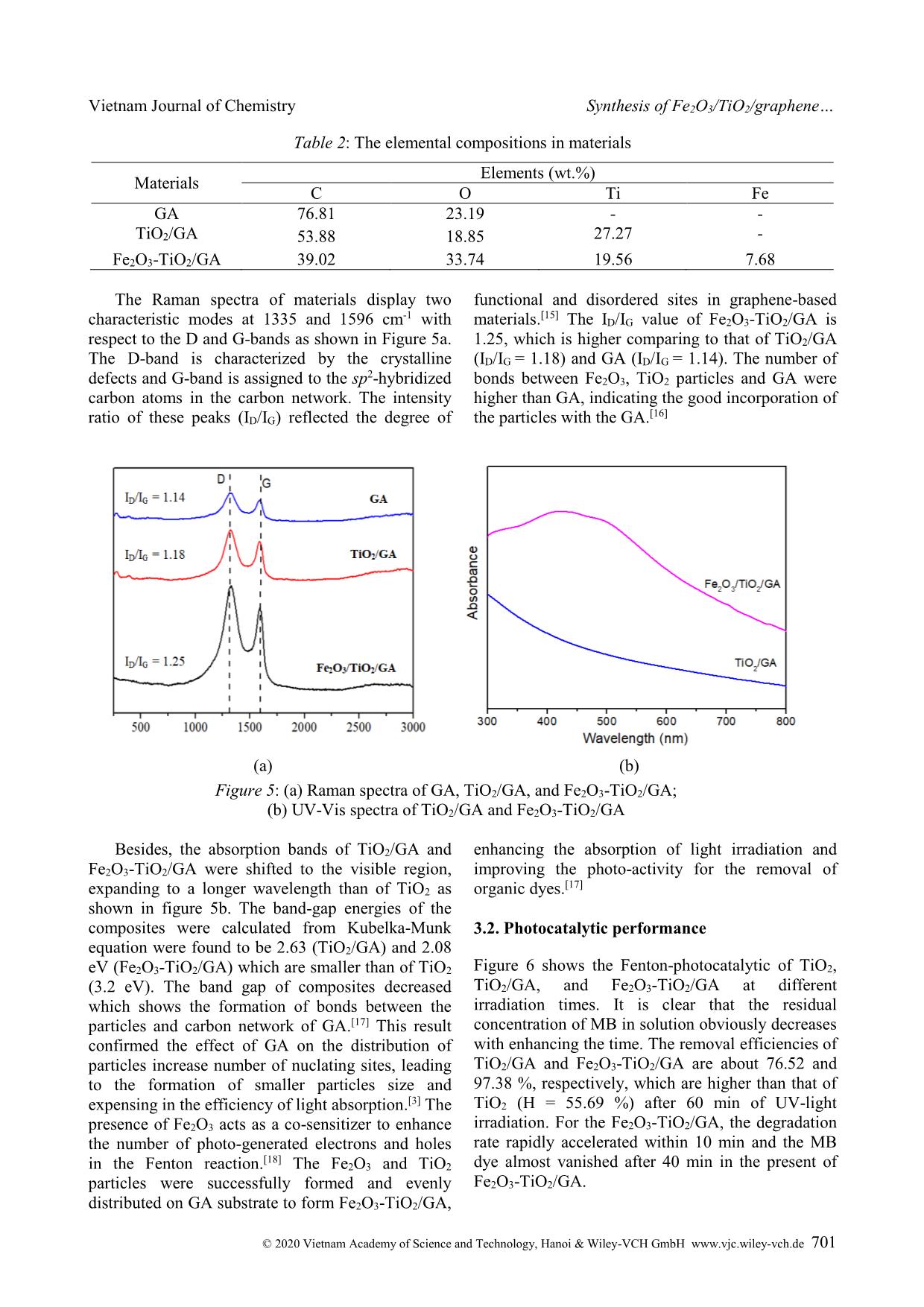
Trang 5
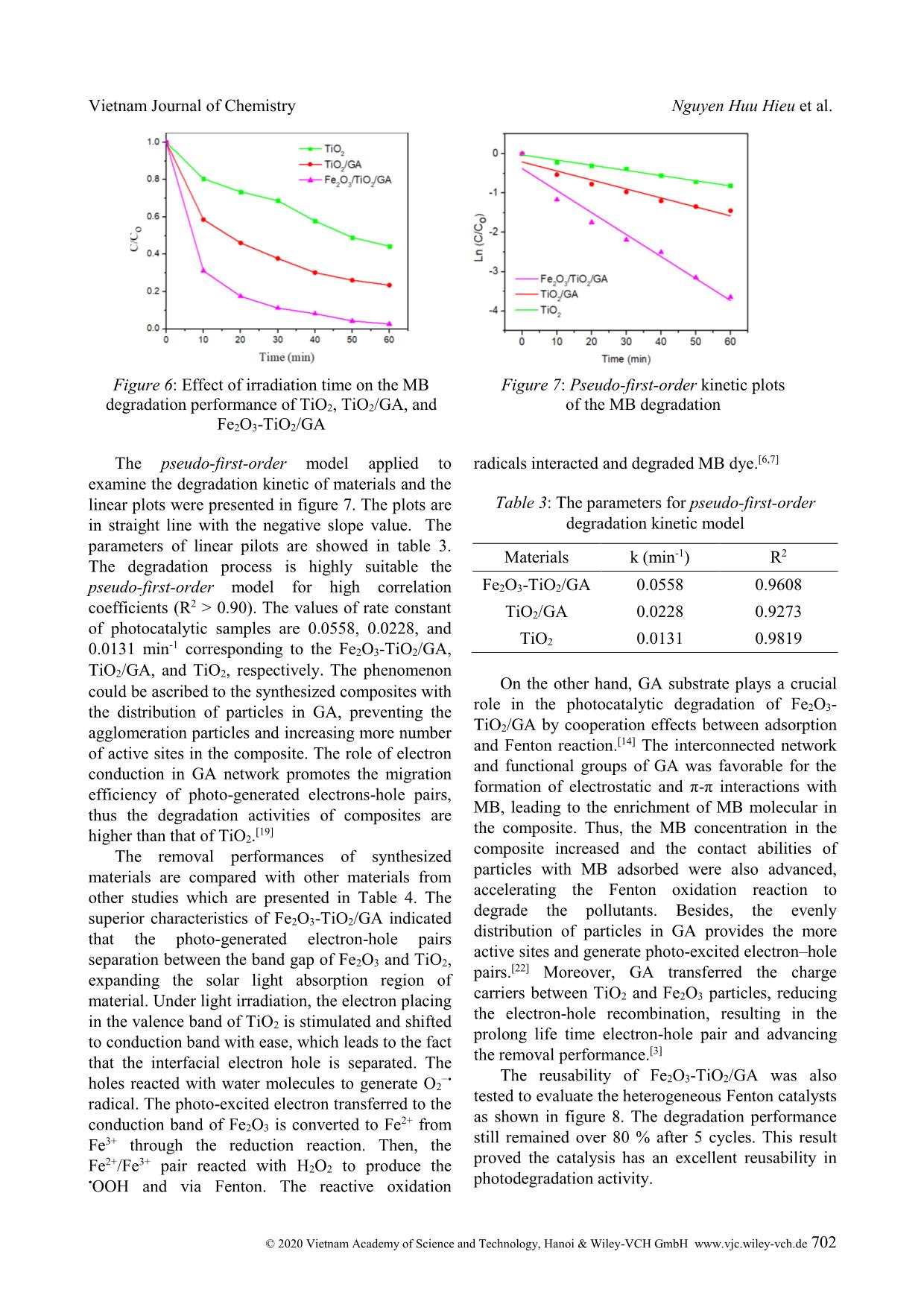
Trang 6
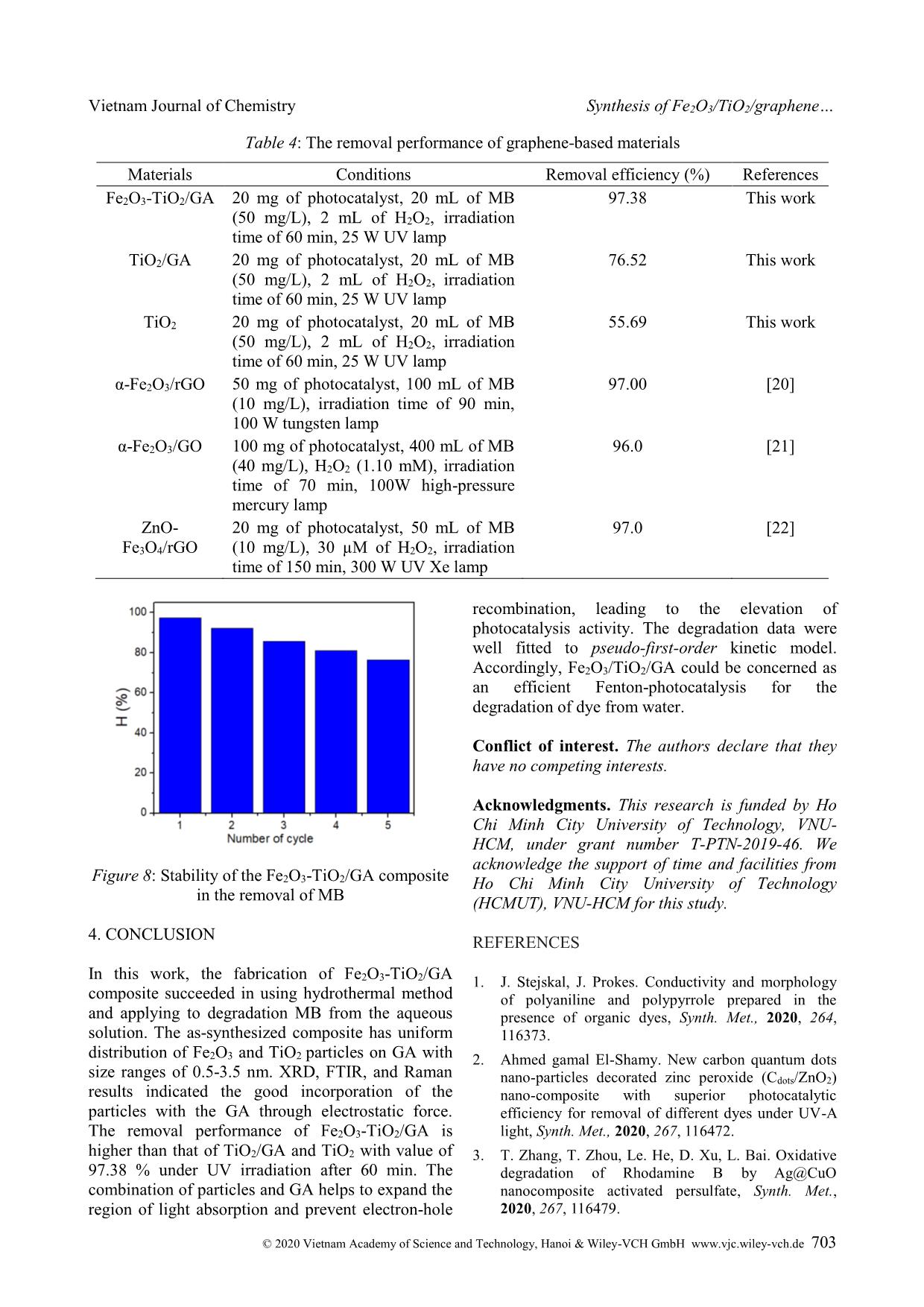
Trang 7
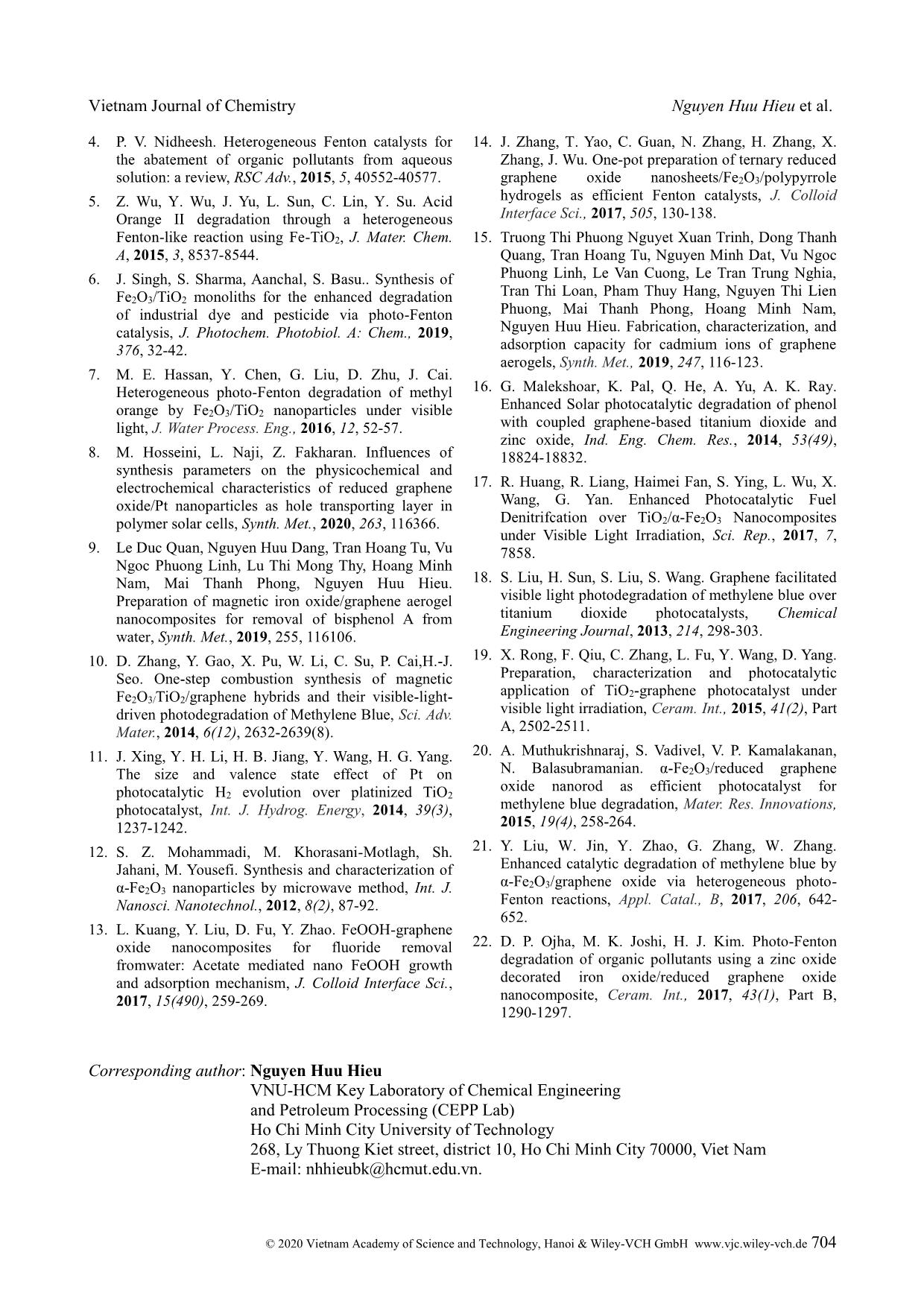
Trang 8
Tóm tắt nội dung tài liệu: Synthesis of Fe₂O₃/TiO₂/graphene aerogel composite as an efficient Fenton-Photocatalyst for removal of methylene blue from aqueous solution
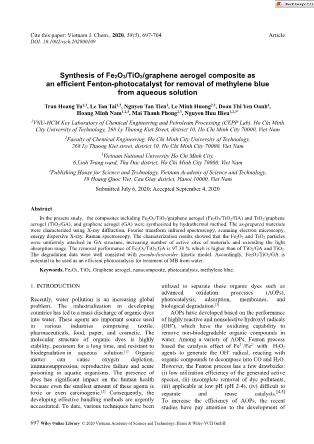
Cite this paper: Vietnam J. Chem., 2020, 58(5), 697-704 Article DOI: 10.1002/vjch.202000109 697 Wiley Online Library © 2020 Vietnam Academy of Science and Technology, Hanoi & Wiley-VCH GmbH Synthesis of Fe2O3/TiO2/graphene aerogel composite as an efficient Fenton-photocatalyst for removal of methylene blue from aqueous solution Tran Hoang Tu1,3, Le Tan Tai1,3, Nguyen Tan Tien1, Le Minh Huong2,3, Doan Thi Yen Oanh4, Hoang Minh Nam1,2,3, Mai Thanh Phong2,3, Nguyen Huu Hieu1,2,3* 1VNU-HCM Key Laboratory of Chemical Engineering and Petroleum Processing (CEPP Lab), Ho Chi Minh City University of Technology, 268 Ly Thuong Kiet Street, district 10, Ho Chi Minh City 70000, Viet Nam 2Faculty of Chemical Engineering, Ho Chi Minh City University of Technology, 268 Ly Thuong Kiet street, district 10, Ho Chi Minh City 70000, Viet Nam 3Vietnam National University Ho Chi Minh City, 6,Linh Trung ward, Thu Duc district, Ho Chi Minh City 70000, Viet Nam 4Publishing House for Science and Technology, Vietnam Academy of Science and Technology, 18 Hoang Quoc Viet, Cau Giay district, Hanoi 10000, Viet Nam Submitted July 6, 2020; Accepted September 4, 2020 Abstract In the present study, the composites including Fe2O3/TiO2/graphene aerogel (Fe2O3/TiO2/GA) and TiO2/graphene aerogel (TiO2/GA), and graphene aerogel (GA) were synthesized by hydrothermal method. The as-prepared materials were characterized using X-ray diffraction, Fourier transform infrared spectroscopy, scanning electron microscopy, energy dispersive X-ray, Raman spectroscopy. The characterization results showed that the Fe2O3 and TiO2 particles were uniformly attached in GA structure, increasing number of active sites of materials and extending the light absorption range. The removal performance of Fe2O3/TiO2/GA is 97.38 % which is higher than of TiO2/GA and TiO2. The degradation data were well consisted with pseudo-first-order kinetic model. Accordingly, Fe2O3/TiO2/GA is potential to be used as an efficient photocatalysis for treatment of MB from water. Keywords. Fe2O3, TiO2, Graphene aerogel, nanocomposite, photocatalysis, methylene blue. 1. INTRODUCTION Recently, water pollution is an increasing global problem. The industrialization in developing countries has led to a mass discharge of organic dyes into water. These agents are important source used in various industries comprising textile, pharmaceuticals, food, paper, and cosmetic. The molecular structure of organic dyes is highly stability, persistent for a long time, and resistant to biodegradation in aqueous solution.[1] Organic matter can cause oxygen depletion, immunosuppression, reproductive failure and acute poisoning in aquatic organisms. The presence of dyes has significant impact on the human health because even the smallest amount of these agents is toxic or even carcinogenic.[2] Consequently, the developing effective handling methods are urgently necessitated. To date, various techniques have been utilized to separate these organic dyes such as advanced oxidation processes (AOPs), photocatalysis, adsorption, membranes, and biological degradation.[3] AOPs have developed based on the performance of highly reactive and nonselective hydroxyl radicals (OH•), which have the oxidizing capability to remove non-biodegradable organic compounds in water. Among a variety of AOPs, Fenton process based the catalysis effect of Fe3+/Fe2+ with H2O2 agents to generate the OH• radical, reacting with organic compounds to decompose into CO and H2O. However, the Fenton process has a few drawbacks: (i) low utilization efficiency of the generated active species, (ii) incomplete removal of dye pollutants, (iii) applicable at low pH (pH 2-4), (iv) difficult to separate and reuse catalysts.[4,5] To increase the efficiency of AOPs, the recent studies have pay attention to the development of Vietnam Journal of Chemistry Nguyen Huu Hieu et al. © 2020 Vietnam Academy of Science and Technology, Hanoi & Wiley-VCH GmbH www.vjc.wiley-vch.de 698 heterogeneous Fenton-like catalysts in removing organic pollutants from wastewater. Titanium oxide (TiO2) is the most common semiconductor photocatalyst used due to its potential benefits such as low cost, non-toxicity, and high stablity. The agglomeration of particles phenomenon and the recombination of photo generated electron-hole pairs decreased the degradation efficiency of TiO2. Additionally, the TiO2 has a large band gap (Eg = 3.2 eV) which absorbed in the ultraviolet light region. To tackle the mentioned above, TiO2 has been doped and coupled with various materials such as Fe2O3, ZnO, WO3, etc. to extent the light absorption and improve the degradation activity of organic pollutant.[3] Hematite (α-Fe2O3), is an iron(III) oxide form, has attracted countless attention due to its diversity in characteristics including low cost, low toxicity, high stability, excellent optical properties, environmental friendly, narrow band gap (2.0-2.2 eV), and oxidative nature.[3] The combination of TiO2 with Fe2O3 to form the heterostructure was considered as an effective way to lower the band gap energy level and improve the absorption light efficiency of the catalyst. Simultaneously, the attaching Fe2O3 and TiO2 particles to the substrate to increase surface area and promote removal efficiency. Graphene aerogel (GA), is a three- dimensional (3D) graphene-based structure, contains many outstanding properties including low density, high porosity and surface area, low thermal conductivity, and high electric conductivity. The GA substrate enabes to create the small size nanoparticles and elevate the production of free radical and advancing the catalytic efficiency of material. Besides, GA substrate promotes the transfer of electrons to prevent the recombination rate of electrons-holes.[ ... erized by the crystalline defects and G-band is assigned to the sp2-hybridized carbon atoms in the carbon network. The intensity ratio of these peaks (ID/IG) reflected the degree of functional and disordered sites in graphene-based materials.[15] The ID/IG value of Fe2O3-TiO2/GA is 1.25, which is higher comparing to that of TiO2/GA (ID/IG = 1.18) and GA (ID/IG = 1.14). The number of bonds between Fe2O3, TiO2 particles and GA were higher than GA, indicating the good incorporation of the particles with the GA.[16] (a) (b) Figure 5: (a) Raman spectra of GA, TiO2/GA, and Fe2O3-TiO2/GA; (b) UV-Vis spectra of TiO2/GA and Fe2O3-TiO2/GA Besides, the absorption bands of TiO2/GA and Fe2O3-TiO2/GA were shifted to the visible region, expanding to a longer wavelength than of TiO2 as shown in figure 5b. The band-gap energies of the composites were calculated from Kubelka-Munk equation were found to be 2.63 (TiO2/GA) and 2.08 eV (Fe2O3-TiO2/GA) which are smaller than of TiO2 (3.2 eV). The band gap of composites decreased which shows the formation of bonds between the particles and carbon network of GA.[17] This result confirmed the effect of GA on the distribution of particles increase number of nuclating sites, leading to the formation of smaller particles size and expensing in the efficiency of light absorption.[3] The presence of Fe2O3 acts as a co-sensitizer to enhance the number of photo-generated electrons and holes in the Fenton reaction.[18] The Fe2O3 and TiO2 particles were successfully formed and evenly distributed on GA substrate to form Fe2O3-TiO2/GA, enhancing the absorption of light irradiation and improving the photo-activity for the removal of organic dyes.[17] 3.2. Photocatalytic performance Figure 6 shows the Fenton-photocatalytic of TiO2, TiO2/GA, and Fe2O3-TiO2/GA at different irradiation times. It is clear that the residual concentration of MB in solution obviously decreases with enhancing the time. The removal efficiencies of TiO2/GA and Fe2O3-TiO2/GA are about 76.52 and 97.38 %, respectively, which are higher than that of TiO2 (H = 55.69 %) after 60 min of UV-light irradiation. For the Fe2O3-TiO2/GA, the degradation rate rapidly accelerated within 10 min and the MB dye almost vanished after 40 min in the present of Fe2O3-TiO2/GA. Vietnam Journal of Chemistry Nguyen Huu Hieu et al. © 2020 Vietnam Academy of Science and Technology, Hanoi & Wiley-VCH GmbH www.vjc.wiley-vch.de 702 Figure 6: Effect of irradiation time on the MB degradation performance of TiO2, TiO2/GA, and Fe2O3-TiO2/GA Figure 7: Pseudo-first-order kinetic plots of the MB degradation The pseudo-first-order model applied to examine the degradation kinetic of materials and the linear plots were presented in figure 7. The plots are in straight line with the negative slope value. The parameters of linear pilots are showed in table 3. The degradation process is highly suitable the pseudo-first-order model for high correlation coefficients (R2 > 0.90). The values of rate constant of photocatalytic samples are 0.0558, 0.0228, and 0.0131 min-1 corresponding to the Fe2O3-TiO2/GA, TiO2/GA, and TiO2, respectively. The phenomenon could be ascribed to the synthesized composites with the distribution of particles in GA, preventing the agglomeration particles and increasing more number of active sites in the composite. The role of electron conduction in GA network promotes the migration efficiency of photo-generated electrons-hole pairs, thus the degradation activities of composites are higher than that of TiO2.[19] The removal performances of synthesized materials are compared with other materials from other studies which are presented in Table 4. The superior characteristics of Fe2O3-TiO2/GA indicated that the photo-generated electron-hole pairs separation between the band gap of Fe2O3 and TiO2, expanding the solar light absorption region of material. Under light irradiation, the electron placing in the valence band of TiO2 is stimulated and shifted to conduction band with ease, which leads to the fact that the interfacial electron hole is separated. The holes reacted with water molecules to generate O2−• radical. The photo-excited electron transferred to the conduction band of Fe2O3 is converted to Fe2+ from Fe3+ through the reduction reaction. Then, the Fe2+/Fe3+ pair reacted with H2O2 to produce the •OOH and via Fenton. The reactive oxidation radicals interacted and degraded MB dye.[6,7] Table 3: The parameters for pseudo-first-order degradation kinetic model Materials k (min-1) R2 Fe2O3-TiO2/GA 0.0558 0.9608 TiO2/GA 0.0228 0.9273 TiO2 0.0131 0.9819 On the other hand, GA substrate plays a crucial role in the photocatalytic degradation of Fe2O3- TiO2/GA by cooperation effects between adsorption and Fenton reaction.[14] The interconnected network and functional groups of GA was favorable for the formation of electrostatic and π-π interactions with MB, leading to the enrichment of MB molecular in the composite. Thus, the MB concentration in the composite increased and the contact abilities of particles with MB adsorbed were also advanced, accelerating the Fenton oxidation reaction to degrade the pollutants. Besides, the evenly distribution of particles in GA provides the more active sites and generate photo-excited electron–hole pairs.[22] Moreover, GA transferred the charge carriers between TiO2 and Fe2O3 particles, reducing the electron-hole recombination, resulting in the prolong life time electron-hole pair and advancing the removal performance.[3] The reusability of Fe2O3-TiO2/GA was also tested to evaluate the heterogeneous Fenton catalysts as shown in figure 8. The degradation performance still remained over 80 % after 5 cycles. This result proved the catalysis has an excellent reusability in photodegradation activity. Vietnam Journal of Chemistry Synthesis of Fe2O3/TiO2/graphene © 2020 Vietnam Academy of Science and Technology, Hanoi & Wiley-VCH GmbH www.vjc.wiley-vch.de 703 Table 4: The removal performance of graphene-based materials Materials Conditions Removal efficiency (%) References Fe2O3-TiO2/GA 20 mg of photocatalyst, 20 mL of MB (50 mg/L), 2 mL of H2O2, irradiation time of 60 min, 25 W UV lamp 97.38 This work TiO2/GA 20 mg of photocatalyst, 20 mL of MB (50 mg/L), 2 mL of H2O2, irradiation time of 60 min, 25 W UV lamp 76.52 This work TiO2 20 mg of photocatalyst, 20 mL of MB (50 mg/L), 2 mL of H2O2, irradiation time of 60 min, 25 W UV lamp 55.69 This work α-Fe2O3/rGO 50 mg of photocatalyst, 100 mL of MB (10 mg/L), irradiation time of 90 min, 100 W tungsten lamp 97.00 [20] α-Fe2O3/GO 100 mg of photocatalyst, 400 mL of MB (40 mg/L), H2O2 (1.10 mM), irradiation time of 70 min, 100W high-pressure mercury lamp 96.0 [21] ZnO- Fe3O4/rGO 20 mg of photocatalyst, 50 mL of MB (10 mg/L), 30 µM of H2O2, irradiation time of 150 min, 300 W UV Xe lamp 97.0 [22] Figure 8: Stability of the Fe2O3-TiO2/GA composite in the removal of MB 4. CONCLUSION In this work, the fabrication of Fe2O3-TiO2/GA composite succeeded in using hydrothermal method and applying to degradation MB from the aqueous solution. The as-synthesized composite has uniform distribution of Fe2O3 and TiO2 particles on GA with size ranges of 0.5-3.5 nm. XRD, FTIR, and Raman results indicated the good incorporation of the particles with the GA through electrostatic force. The removal performance of Fe2O3-TiO2/GA is higher than that of TiO2/GA and TiO2 with value of 97.38 % under UV irradiation after 60 min. The combination of particles and GA helps to expand the region of light absorption and prevent electron-hole recombination, leading to the elevation of photocatalysis activity. The degradation data were well fitted to pseudo-first-order kinetic model. Accordingly, Fe2O3/TiO2/GA could be concerned as an efficient Fenton-photocatalysis for the degradation of dye from water. Conflict of interest. The authors declare that they have no competing interests. Acknowledgments. This research is funded by Ho Chi Minh City University of Technology, VNU- HCM, under grant number T-PTN-2019-46. We acknowledge the support of time and facilities from Ho Chi Minh City University of Technology (HCMUT), VNU-HCM for this study. REFERENCES 1. J. Stejskal, J. Prokes. Conductivity and morphology of polyaniline and polypyrrole prepared in the presence of organic dyes, Synth. Met., 2020, 264, 116373. 2. Ahmed gamal El-Shamy. New carbon quantum dots nano-particles decorated zinc peroxide (Cdots/ZnO2) nano-composite with superior photocatalytic efficiency for removal of different dyes under UV-A light, Synth. Met., 2020, 267, 116472. 3. T. Zhang, T. Zhou, Le. He, D. Xu, L. Bai. Oxidative degradation of Rhodamine B by Ag@CuO nanocomposite activated persulfate, Synth. Met., 2020, 267, 116479. Vietnam Journal of Chemistry Nguyen Huu Hieu et al. © 2020 Vietnam Academy of Science and Technology, Hanoi & Wiley-VCH GmbH www.vjc.wiley-vch.de 704 4. P. V. Nidheesh. Heterogeneous Fenton catalysts for the abatement of organic pollutants from aqueous solution: a review, RSC Adv., 2015, 5, 40552-40577. 5. Z. Wu, Y. Wu, J. Yu, L. Sun, C. Lin, Y. Su. Acid Orange II degradation through a heterogeneous Fenton-like reaction using Fe-TiO2, J. Mater. Chem. A, 2015, 3, 8537-8544. 6. J. Singh, S. Sharma, Aanchal, S. Basu.. Synthesis of Fe2O3/TiO2 monoliths for the enhanced degradation of industrial dye and pesticide via photo-Fenton catalysis, J. Photochem. Photobiol. A: Chem., 2019, 376, 32-42. 7. M. E. Hassan, Y. Chen, G. Liu, D. Zhu, J. Cai. Heterogeneous photo-Fenton degradation of methyl orange by Fe2O3/TiO2 nanoparticles under visible light, J. Water Process. Eng., 2016, 12, 52-57. 8. M. Hosseini, L. Naji, Z. Fakharan. Influences of synthesis parameters on the physicochemical and electrochemical characteristics of reduced graphene oxide/Pt nanoparticles as hole transporting layer in polymer solar cells, Synth. Met., 2020, 263, 116366. 9. Le Duc Quan, Nguyen Huu Dang, Tran Hoang Tu, Vu Ngoc Phuong Linh, Lu Thi Mong Thy, Hoang Minh Nam, Mai Thanh Phong, Nguyen Huu Hieu. Preparation of magnetic iron oxide/graphene aerogel nanocomposites for removal of bisphenol A from water, Synth. Met., 2019, 255, 116106. 10. D. Zhang, Y. Gao, X. Pu, W. Li, C. Su, P. Cai,H.-J. Seo. One-step combustion synthesis of magnetic Fe2O3/TiO2/graphene hybrids and their visible-light- driven photodegradation of Methylene Blue, Sci. Adv. Mater., 2014, 6(12), 2632-2639(8). 11. J. Xing, Y. H. Li, H. B. Jiang, Y. Wang, H. G. Yang. The size and valence state effect of Pt on photocatalytic H2 evolution over platinized TiO2 photocatalyst, Int. J. Hydrog. Energy, 2014, 39(3), 1237-1242. 12. S. Z. Mohammadi, M. Khorasani-Motlagh, Sh. Jahani, M. Yousefi. Synthesis and characterization of α-Fe2O3 nanoparticles by microwave method, Int. J. Nanosci. Nanotechnol., 2012, 8(2), 87-92. 13. L. Kuang, Y. Liu, D. Fu, Y. Zhao. FeOOH-graphene oxide nanocomposites for fluoride removal fromwater: Acetate mediated nano FeOOH growth and adsorption mechanism, J. Colloid Interface Sci., 2017, 15(490), 259-269. 14. J. Zhang, T. Yao, C. Guan, N. Zhang, H. Zhang, X. Zhang, J. Wu. One-pot preparation of ternary reduced graphene oxide nanosheets/Fe2O3/polypyrrole hydrogels as efficient Fenton catalysts, J. Colloid Interface Sci., 2017, 505, 130-138. 15. Truong Thi Phuong Nguyet Xuan Trinh, Dong Thanh Quang, Tran Hoang Tu, Nguyen Minh Dat, Vu Ngoc Phuong Linh, Le Van Cuong, Le Tran Trung Nghia, Tran Thi Loan, Pham Thuy Hang, Nguyen Thi Lien Phuong, Mai Thanh Phong, Hoang Minh Nam, Nguyen Huu Hieu. Fabrication, characterization, and adsorption capacity for cadmium ions of graphene aerogels, Synth. Met., 2019, 247, 116-123. 16. G. Malekshoar, K. Pal, Q. He, A. Yu, A. K. Ray. Enhanced Solar photocatalytic degradation of phenol with coupled graphene-based titanium dioxide and zinc oxide, Ind. Eng. Chem. Res., 2014, 53(49), 18824-18832. 17. R. Huang, R. Liang, Haimei Fan, S. Ying, L. Wu, X. Wang, G. Yan. Enhanced Photocatalytic Fuel Denitrifcation over TiO2/α-Fe2O3 Nanocomposites under Visible Light Irradiation, Sci. Rep., 2017, 7, 7858. 18. S. Liu, H. Sun, S. Liu, S. Wang. Graphene facilitated visible light photodegradation of methylene blue over titanium dioxide photocatalysts, Chemical Engineering Journal, 2013, 214, 298-303. 19. X. Rong, F. Qiu, C. Zhang, L. Fu, Y. Wang, D. Yang. Preparation, characterization and photocatalytic application of TiO2-graphene photocatalyst under visible light irradiation, Ceram. Int., 2015, 41(2), Part A, 2502-2511. 20. A. Muthukrishnaraj, S. Vadivel, V. P. Kamalakanan, N. Balasubramanian. α-Fe2O3/reduced graphene oxide nanorod as efficient photocatalyst for methylene blue degradation, Mater. Res. Innovations, 2015, 19(4), 258-264. 21. Y. Liu, W. Jin, Y. Zhao, G. Zhang, W. Zhang. Enhanced catalytic degradation of methylene blue by α-Fe2O3/graphene oxide via heterogeneous photo- Fenton reactions, Appl. Catal., B, 2017, 206, 642- 652. 22. D. P. Ojha, M. K. Joshi, H. J. Kim. Photo-Fenton degradation of organic pollutants using a zinc oxide decorated iron oxide/reduced graphene oxide nanocomposite, Ceram. Int., 2017, 43(1), Part B, 1290-1297. Corresponding author: Nguyen Huu Hieu VNU-HCM Key Laboratory of Chemical Engineering and Petroleum Processing (CEPP Lab) Ho Chi Minh City University of Technology 268, Ly Thuong Kiet street, district 10, Ho Chi Minh City 70000, Viet Nam E-mail: nhhieubk@hcmut.edu.vn.
File đính kèm:
 synthesis_of_feotiographene_aerogel_composite_as_an_efficien.pdf
synthesis_of_feotiographene_aerogel_composite_as_an_efficien.pdf

